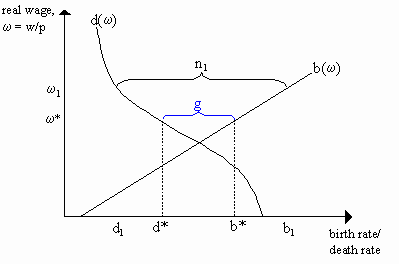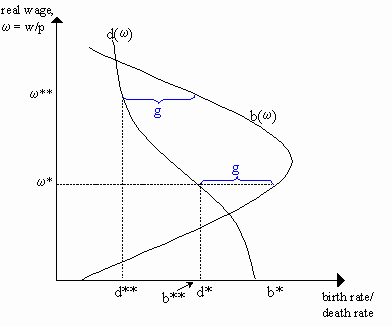|
Contents (A) The Natural Wage The idea of a "natural wage" plays a large role in Ricardo's (1817) theory. He traces its source to the Malthusian population theory. Indeed, Malthus's (1798, 1872) ruminations on "misery and vice" suggest that there is a "natural" subsistence level under which population growth remains precisely equal to growth of food supply. Letting w be the nominal wage and p the price of provisions, then the real wage is merely w/p, roughly the amount of food that the average worker can put on his table. To ease notation, let w = w/p. (A) The Natural Wage We can define population growth as the difference between fertility and mortality, so n = (b - d), where b is the birth rate and d is the death rate. Following Malthus's arguments, we can posit the following relationships:
so as the real wage w rises, the birth rate increases and the death rate decreases. The two curves are depicted in Figure 1. The shapes are not very meaningful, although it is useful to think of the birth rate rising steadily in response to wages, while mortality responds a bit more sharply around the middle.
The "natural real wage", w*, is the rate at which population grows at the same rate as the means of subsistence, g = n. Specifically, we define w* as the real wage which fulfills the following condition:
If we had the precise shapes of b(·) and d(·), we would be able to derive w* from this expression. Geometrically, at the natural real wage, the distance between the birth rate and the death rate functions is exactly equal to g. As shown in Figure 1, the natural real wage w* can be found by fitting a "wedge" of size g between the curves. The corresponding natural birth rate is b* and the natural death rate is d*. [Note: Ricardo (1817) took a static version of this story, so g = 0 and thus the natural wage is defined where the birth rate is equal to the death rate and population is constant. In the Ricardian version, the natural real wage is found at the intersection of the b(·) and d(·) curves.] If the actual real wage is higher than the natural real wage, then population is growing faster than subsistence. For instance, if the real wage is w1 in Figure 1, then the birth rate exceeds the death rate by more than g, i.e. n1 = b1 - d1 > g. The converse applies if the real wage is below the natural real wage. The tragedy of the Malthusian model is that the natural real wage is stable. In other words, if the real wage is higher than the natural wage, then there are natural forces that pull it back down; if the real wage is too low, then forces will pull it back up. Let Yt be the total available food supply at time t and Lt be the total amount of labor at time t. Abstracting from capital and profits, then immediately we know that, in equilibrium, ptYt = wtLt, the total amount of wage bill must purchase the total stock of food available at time t. We can rewrite this as:
Or, in dynamic terms:
Now, by definition of the growth of means of subsistence, we know that g = (dY/dt)/Y and by definition of actual population growth, n = (dL/dt)/L. Thus:
or, substituting in for n: dw/dt = w[g - (b(w) + d(w))] which is a first order differential equation in w. The steady-state w* is defined where dw/dt = 0, which, from the differential equation, indicates that this is true when g = b(w*) - d(w*), i.e. the same natural real wage. (B) The "Iron Law" Is the natural wage, w*, stable? This depends on the shape of the curves b(·) and d(·), but it can be easily be verified that as long as b(·) is upward-sloping and d(·) is downward sloping, then:
So, a rise in real wage above the natural wage will set dynamics into motion that lead to a reduction in the real wage. The converse applies for a fall in the real wage. Succinctly, then, the Malthusian theory suggests that any increase in the real wage above its natural rate will lead to an explosion in population growth that outstrips the food supply growth, n > g. As a result, the real wage w will be driven back down -- whether from falling w as a result of excess supply in the labor market, or a rising p from excess demand in the market for provisions, or both. So the Malthusian model implies that there is a natural real wage w* which keeps population growth equal to food supply growth and serves as a gravitational center so that departures from the natural wage will eventually return to it. Thus, the Malthusian theory of the natural wage is often referred to as the "iron law of wages". (C) Policy Effects Malthusian policy prescriptions can be illustrated with the natural wage apparatus. Malthus's regarded propositions that decreased the death rate (e.g. lowering of infant mortality through better health and sanitation, etc.), would simply shift the d(w) curve in Figure 1 to the left, thereby lowering the natural real wage. His preferred policy, "moral restraint" (i.e. lowering the birth rate by abstinence) would shift the b(w) curve in Figure 1 to the left and thus increase the natural real wage. (D) The Demographic Transition The "demographic transition" which Malthus suggested can be captured by a backward-bending birth rate schedule, as shown in Figure 2. Notice that for a given growth of food supply, g, there are two natural wage equilibria where g = b(w) - d(w), depicted in Figure 2 as w* and w**. The first equilibrium is Malthus's dismal low-wage equilibrium, while the second one has a considerably higher wage.
Notice that the two equilibria respond differently to changes in population. If the economy is stuck at w*, then an increase in the birth rate/decline in the death rate will reduce the natural real wage w* -- just as Malthus's dismal hypothesis predicts. However, if we can somehow achieve the high-wage equilibrium, w**, then an increase in birth rate/decline in death rate will increase the natural real wage w**.
|
All rights reserved, Gonçalo L. Fonseca



